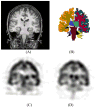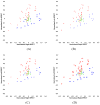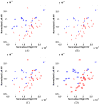Quantitative multi-compartmental SPECT image analysis for lateralization of temporal lobe epilepsy
- PMID: 21454055
- PMCID: PMC3109162
- DOI: 10.1016/j.eplepsyres.2011.02.011
Quantitative multi-compartmental SPECT image analysis for lateralization of temporal lobe epilepsy
Abstract
This study assesses the utility of compartmental analysis of SPECT data in lateralizing ictal onset in cases of a putative mesial temporal lobe epilepsy (mTLE). An institutional archival review provided 46 patients (18M, 28F) operated for a putative mTLE who achieved an Engel class Ia postoperative outcome. This established the standard to assure a true ictal origin. Ictal and interictal SPECT images were separately coregistered to T1-weighted (T1W) magnetic resonance (MR) image using a rigid transformation and the intensities matched with an l(1) norm minimization technique. The T1W MR image was segmented into separate structures using an atlas-based automatic segmentation technique with the hippocampi manually segmented to improve accuracy. Mean ictal-interictal intensity difference values were calculated for select subcortical structures and the accuracy of lateralization evaluated using a linear classifier. Hippocampal SPECT analysis yielded the highest lateralization accuracy (91%) followed by the amygdala (87%), putamen (67%) and thalamus (61%). Comparative FLAIR and volumetric analyses yielded 89% and 78% accuracies, respectively. A multi-modality analysis did not generate a higher accuracy (89%). A quantitative anatomically compartmented approach to SPECT analysis yields a particularly high lateralization accuracy in the case of mTLE comparable to that of quantitative FLAIR MR imaging. Hippocampal segmentation in this regard correlates well with ictal origin and shows good reliability in the preoperative analysis.
Copyright © 2011 Elsevier B.V. All rights reserved.
Conflict of interest statement
The authors declare that they have no conflict of interest.
Figures







Similar articles
-
Correlations of interictal FDG-PET metabolism and ictal SPECT perfusion changes in human temporal lobe epilepsy with hippocampal sclerosis.Neuroimage. 2006 Aug 15;32(2):684-95. doi: 10.1016/j.neuroimage.2006.04.185. Epub 2006 Jun 9. Neuroimage. 2006. PMID: 16762567
-
Single photon emission computed tomography-EEG relations in temporal lobe epilepsy.Neurology. 1997 Oct;49(4):981-91. doi: 10.1212/wnl.49.4.981. Neurology. 1997. PMID: 9339677
-
Cerebral perfusion changes in mesial temporal lobe epilepsy: SPM analysis of ictal and interictal SPECT.Neuroimage. 2005 Jan 1;24(1):101-10. doi: 10.1016/j.neuroimage.2004.08.005. Neuroimage. 2005. PMID: 15588601
-
Positron emission tomography and single photon emission computed tomography in epilepsy care.Semin Nucl Med. 2003 Apr;33(2):88-104. doi: 10.1053/snuc.2003.127301. Semin Nucl Med. 2003. PMID: 12756642 Review.
-
Qualitative and quantitative imaging of the hippocampus in mesial temporal lobe epilepsy with hippocampal sclerosis.Neuroimaging Clin N Am. 2004 Aug;14(3):373-400, vii. doi: 10.1016/j.nic.2004.04.004. Neuroimaging Clin N Am. 2004. PMID: 15324854 Review.
Cited by
-
Time-shift homotopic connectivity in mesial temporal lobe epilepsy.AJNR Am J Neuroradiol. 2014 Sep;35(9):1746-52. doi: 10.3174/ajnr.A3934. Epub 2014 Apr 17. AJNR Am J Neuroradiol. 2014. PMID: 24742802 Free PMC article.
-
Predictive value of metabolic and perfusion changes outside the seizure onset zone for postoperative outcome in patients with refractory focal epilepsy.Acta Neurol Belg. 2022 Apr;122(2):325-335. doi: 10.1007/s13760-020-01569-y. Epub 2021 Feb 5. Acta Neurol Belg. 2022. PMID: 33544336
-
Data mining MR image features of select structures for lateralization of mesial temporal lobe epilepsy.PLoS One. 2018 Aug 1;13(8):e0199137. doi: 10.1371/journal.pone.0199137. eCollection 2018. PLoS One. 2018. PMID: 30067753 Free PMC article.
-
[Optimized multi-scale entropy to localize epileptogenic hemisphere of temporal lobe epilepsy based on resting-state functional magnetic resonance imaging].Sheng Wu Yi Xue Gong Cheng Xue Za Zhi. 2021 Dec 25;38(6):1163-1172. doi: 10.7507/1001-5515.202011048. Sheng Wu Yi Xue Gong Cheng Xue Za Zhi. 2021. PMID: 34970900 Free PMC article. Chinese.
-
In Vivo Mapping and Quantification of Creatine Using Chemical Exchange Saturation Transfer Imaging in Rat Models of Epileptic Seizure.Mol Imaging Biol. 2019 Apr;21(2):232-239. doi: 10.1007/s11307-018-1243-6. Mol Imaging Biol. 2019. PMID: 29951847
References
-
- Annegers JF, Hauser WA, Coan SP, Rocca WA. A population-based study of seizures after traumatic brain injuries. N Engl J Med. 1998;338:20–24. - PubMed
-
- Aubert-Broche B, Grova C, Jannin P, Buvat I, Benali H, Gibaud B. Detection of inter-hemispheric asymmetries of brain perfusion in SPECT. Physics in Medicine and Biology. 2003;48:1505–1517. - PubMed
-
- Aubert-Broche B, Jannin P, Biraben A, Bernard AM, Haegelen C, Le Jeune FP, Gibaud B. Evaluation of methods to detect interhemispheric asymmetry on cerebral perfusion SPECT: application to epilepsy. Journal of Nuclear Medicine. 2005;46:707–713. - PubMed
-
- Avery RA, Zubal IG, Stokking R, Studholme C, Corsi M, Seibyl JP, Spencer SS. Decreased cerebral blood flow during seizures with ictal SPECT injections. Epilepsy Res. 2000;40:53–61. - PubMed
Publication types
MeSH terms
Substances
Grants and funding
LinkOut - more resources
Full Text Sources

